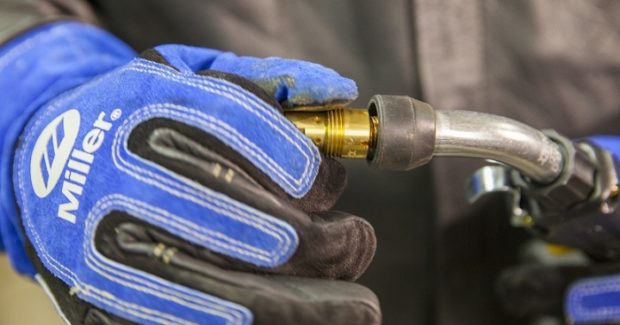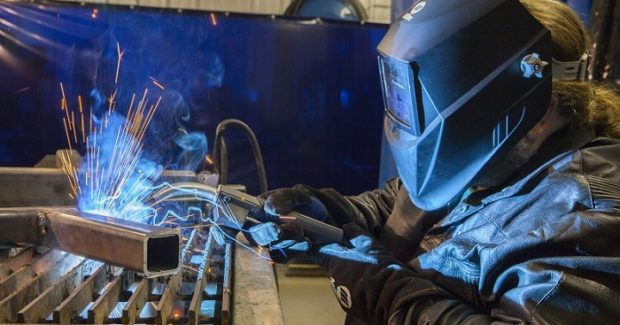Signs Your MIG Gun is Overheating – and How to Prevent It
Gun overheating can be a symptom of numerous problems, and it can result in catastrophic failure if ignored. Here are some common signs and causes of MIG gun overheating to be aware of that can help you prevent or quickly remedy the problem.
Posted: April 19, 2017
An overheated MIG gun can result in downtime, wasted consumables and lower productivity, costing a shop more time and money than necessary. Gun overheating can be a symptom of numerous problems, and it can result in catastrophic failure if ignored. Being aware of the common signs and causes of MIG gun overheating can help prevent or quickly remedy the problem. Always know the gun’s amperage and duty cycle rating and the parameters of the welding application: This information tells you how long a specific gun can be used and under what conditions. Gun manufacturers test and rate their products to prevent overheating. A gun’s assigned rating reflects the temperatures above which the handle or cable becomes uncomfortably warm, not the point at which the gun risks damage or failure. In addition, specific duty cycles are tested for each gun, such as 100 percent duty cycle with 100 percent carbon dioxide (CO2) or a 60 percent duty cycle with a mixed shielding gas (CO2/Argon). Most manufacturers list the amperage-to-duty-cycle ratios in product literature, so research a gun’s rating before purchasing.
WATCH FOR THE SIGNS
There are definite signs that may indicate the MIG gun is overheating:
- Vibration or “chatter” of the gun is a common sign of overheating. This vibration in the gun handle often comes with a rapid changing of the arc length, making it appear the wire is vibrating. Decrease the duty cycle to address this issue. Another solution is to extend the wire stickout; even a slightly longer stickout can significantly reduce contact tip temperature, and with it, gun temperature.
- Heat drawn through the gun to the cable is another sign of overheating. When you begin welding, the front-end consumables take the heat of the weld puddle. As welding continues, heat transfers into the neck and handle – and eventually into the cable. When heat is noticeable at the back end of the gun and in the cable, it’s likely the gun has exceeded its duty cycle. In some cases, the gun may become so hot that it’s uncomfortable to hold. Utilizing cone nut-style end fittings, rather than crimp sleeve-style fittings, can provide more forgiving tolerances to help prevent overheating. Also, it may help to use heavier duty front-end consumables that are designed to fend off heat for longer.
- Liner oxidation or discoloration can occur when there is too much heat, and can also result from an issue somewhere else in the gun that is causing resistance and lack of good electrical contact. Resistance creates heat, and if that heat finds its way through the liner it can cause “bluing,” or oxidation at the end of the liner. If you change the liner (spurred by poor performance) and notice discoloration, it’s likely that a symptom of overheating has been overlooked elsewhere in the gun.
COMMON CAUSES OF OVERHEATING
In addition to knowing the signs of gun overheating, it is important to understand the common causes that lead to it:
- Exceeding duty cycle: Operating the gun for too long is a main cause of overheating. Know the duty cycle and amperage ratings of the gun and don’t exceed the duty cycle when possible. When a gun is consistently overheating, you likely need a larger capacity gun for the application. This allows for longer welding at higher amperages. However, in welding applications that require short bursts of welding – such as 30 one-inch welds – a larger amperage gun is often not needed and a lighter, more flexible gun may be the right choice. Be aware that shielding gas also plays a role in gun temperature. Mixed gases typically run hotter, while 100 percent CO2 provides more latent cooling to help keep the welding process cooler.
- Not enough stickout: Improper stickout or recess of consumables can be another cause of gun overheating. Adjust stickout to make it slightly longer or change the consumables. A longer stickout, combined with a higher wire feed speed and voltage, helps keep front-end consumables out of the weld puddle and running cooler. Also, when the application calls for a higher duty cycle or amperage and the gun has a flush nozzle, pull the tip back 1/8 in to 1/4 in to better protect it from the heat. Using a slightly longer gun neck can also help absorb more heat from the weld puddle, reducing overheating opportunities.
- Improper or faulty ground: A faulty ground or a ground that is too far from the point of the weld can also cause front-end consumables to overheat and wear prematurely. To help combat this problem, position the ground as close to the weld puddle as possible and use as large of a cable as possible to provide a good connection.
PREVENTING GUN OVERHEATING
Knowing these warning signs of gun overheating can help prevent the costly downtime. In applications where the gun is frequently overheating, it may be necessary to switch to heavier-duty consumables or use a larger capacity gun. By implementing some best practices, you can also help reduce the occurrence of MIG gun overheating to help maximize productivity and savings.






